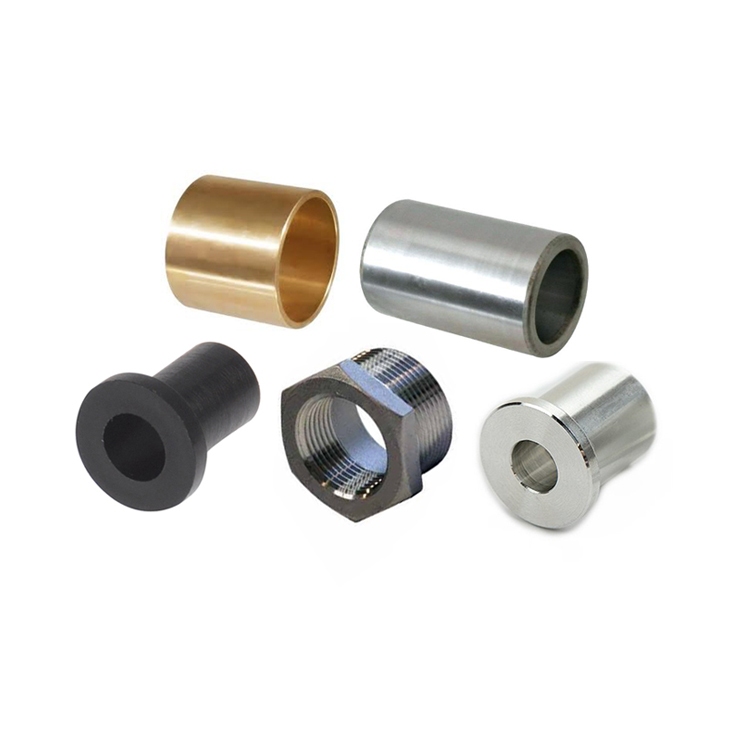What is a Metal Bushing?
A metal bushing is a cylindrical component designed to reduce friction, absorb shock, and provide precise alignment between moving parts in mechanical systems. These bushings are typically manufactured from high-grade metals or alloys, offering superior durability and performance compared to polymer alternatives. Key Materials include bronze (C93200 bearing bronze with 83% Cu, 7% Pb, 7% Sn), stainless Steel (Grade 304 or 316 with 18-20% Cr and 8-12% Ni), and sintered metals (iron-copper composites with 10-30% porosity for oil retention).

Technical Characteristics of Metal Bushings
Load Capacity: Bronze bushings withstand static loads up to 60 MPa and dynamic loads up to 35 MPa, while steel bushings can handle over 100 MPa static loads in high-pressure applications.
Temperature Range: Standard bronze bushings operate effectively from -40°C to +250°C, with special alloys extending this to 400°C. Stainless steel variants maintain dimensional stability up to 800°C in oxidizing environments.
Friction Coefficients: Oil-impregnated sintered bronze exhibits μ=0.08-0.12 under lubricated conditions, while PTFE-coated steel bushings achieve μ=0.05-0.10 with minimal lubrication.
Wear Resistance: Hardened steel bushings (HRC 58-62) demonstrate wear rates below 0.001 mm³/Nm in abrasive environments, outperforming polymer alternatives by 5-10x in lifespan.
Dimensional Precision: Precision-ground metal bushings maintain IT6-IT7 tolerance grades (ISO 286) with surface finishes of Ra 0.4-0.8 μm for critical applications.
Applications of Metal Bushings
Metal bushings serve critical functions across multiple Industries:
Automotive Systems
Suspension components: Control arm bushings withstand peak loads of 5-8 kN while damping vibrations at 10-100 Hz frequencies.
Transmission systems: Bronze guide bushings in manual transmissions operate at PV factors up to 3.5 MPa·m/s with continuous oil lubrication.
Steering linkages: Hardened steel bushings maintain ±0.05 mm radial clearance over 150,000 km service intervals.
Industrial Machinery
Hydraulic cylinders: Stainless steel wear bands provide 0.1-0.3 mm running clearance at 21 MPa system pressures.
Conveyor systems: Sintered bronze bushings in roller chains operate with 30-50% less lubrication compared to standard bearings.
Pump shafts: Silicon bronze bushings resist cavitation erosion at flow velocities exceeding 15 m/s.
Aerospace and Defense
Actuator systems: Self-lubricating bronze bushings meet MIL-B-5687F specifications for -54°C to +175°C operation.
Landing gear: Hard-coated aluminum bushings reduce weight by 40% while maintaining 200,000 cycle durability.
Maintenance Procedures for Metal Bushings
Lubrication Management
Oil-impregnated bushings: Replenish lubricant every 500-2,000 operating hours using ISO VG 68-100 oils with ≥4% extreme pressure additives.
Dry-running bushings: PTFE-lined types require inspection every 10,000 cycles for wear pattern analysis.
Grease lubrication: Apply lithium complex greases (NLGI 2) with 3-5% volume replenishment quarterly.
Wear Monitoring
Measure radial clearance with dial indicators (accuracy ±0.01 mm) during scheduled maintenance.
Replace bushings when wear exceeds 10% of initial wall thickness or 0.1 mm diametral clearance in precision applications.
Conspect oil analysis for >50 ppm bronze/iron particles indicating abnormal wear.
Installation Best Practices
Maintain H7/s6 interference fits for steel bushings in aluminum housings (0.02-0.05 mm interference).
Use induction heaters to achieve 150-200°C for interference fit installations.
Apply thread locking compounds (Loctite 648) on retaining screws with 0.05-0.10 mm gap fill capability.
Corrosion Prevention
For marine environments, specify aluminum bronze (C95400) with >78 dB salt spray resistance per ASTM B117.
Apply zinc-nickel plating (8-12 μm) on steel bushings for 1,000+ hour salt fog protection.
Implement cathodic protection systems when bushings operate in >5% NaCl solutions.





 English
English

